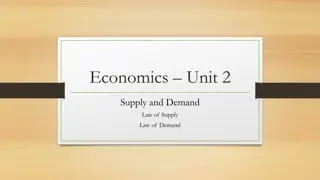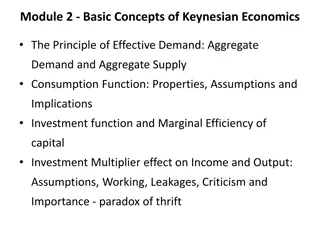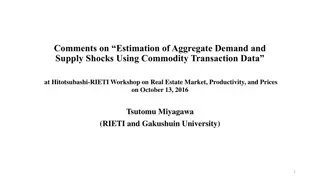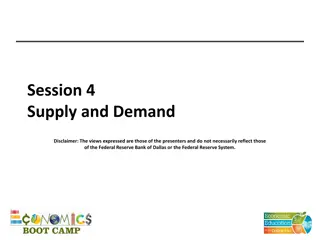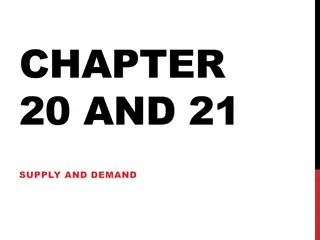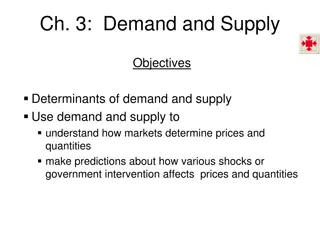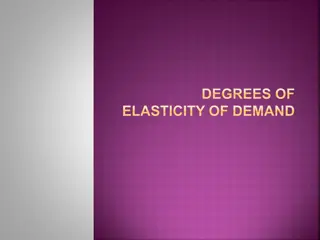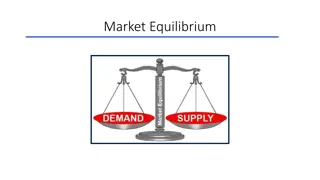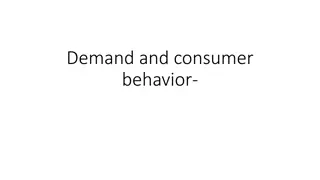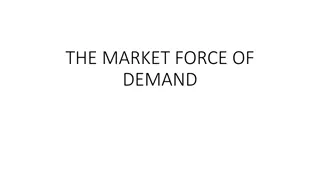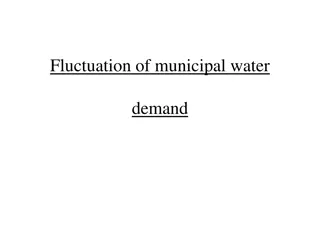Supply and Demand in a Competitive Market
This content delves into the concept of supply and demand in a competitive market as described by the renowned economists Paul Krugman and Robin Wells. It covers the basics of a competitive market, the dynamics of supply and demand curves, movements along curves, market equilibrium, and how prices adjust in cases of shortages or surpluses. The discussion also includes the importance of demand schedules, demand curves, and factors influencing demand changes.
Download Presentation

Please find below an Image/Link to download the presentation.
The content on the website is provided AS IS for your information and personal use only. It may not be sold, licensed, or shared on other websites without obtaining consent from the author.If you encounter any issues during the download, it is possible that the publisher has removed the file from their server.
You are allowed to download the files provided on this website for personal or commercial use, subject to the condition that they are used lawfully. All files are the property of their respective owners.
The content on the website is provided AS IS for your information and personal use only. It may not be sold, licensed, or shared on other websites without obtaining consent from the author.
E N D
Presentation Transcript
THIRD EDITION ECONOMICS and MACROECONOMICS Paul Krugman | Robin Wells Chapter 3 Supply and Demand
What a competitive market is and how it is described by the supply and demand model What the demand curve and supply curve are The difference between movements along a curve and shifts of a curve How the supply and demand curves determine a market s equilibrium price and equilibrium quantity In the case of a shortage or surplus, how price moves the market back to equilibrium WHAT YOU WILL LEARN IN THIS CHAPTER
Supply and Demand A competitive market: Many buyers and sellers Same good or service The supply and demand model is a model of how a competitive market works. Five key elements: Demand curve Supply curve Demand and supply curve shifts Market equilibrium Changes in the market equilibrium
Demand Schedule A demand schedule shows how much of a good or service consumers will want to buy at different prices. Demand Schedule for Cotton Quantity of cotton demanded (billions of pounds) Price of cotton (per pound) $2.00 7.1 7.5 1.75 8.1 1.50 8.9 1.25 10.0 1.00 11.5 0.75 14.2 0.50
Demand Curve Price of cotton (per pound) A demand curve is the graphical representation of the demand schedule. It shows how much of a good or service consumers want to buy at any given price. $2.00 1.75 1.50 1.25 1.00 0.75 As price rises, the quantity demanded falls Demand curve, D 0.50 0 7 9 11 13 15 17 Quantity of cotton (billions of pounds)
An Increase in Demand An increase in population and other factors generate an increase in demand. a rise in the quantity demanded at any given price Demand Schedules for Cotton Quantity of cotton demanded (billions of pounds) Price of cotton (per pound) in 2007 in 2010 7.1 8.5 $2.00 1.75 This is represented by the two demand schedules one showing demand in 2007, before the rise in population, the other showing demand in 2010, after the rise in population. 7.5 9.0 1.50 8.1 9.7 1.25 8.9 10.7 1.00 10.0 12.0 0.75 11.5 13.8 0.50 14.2 17.0
An Increase in Demand Price of cotton (per pound) $2.00 Increase in population more cotton clothing users 1.75 Demand curve in 2010 1.50 1.25 1.00 0.75 Demand curve in 2007 0.50 D1 D2 0 7 9 11 13 15 17 Quantity of cotton (billions of pounds) A shift of the demand curve is a change in the quantity demanded at any given price, represented by the change of the original demand curve to a new position, denoted by a new demand curve.
Movement Along the Demand Curve A movement along the demand curve is a change in the quantity demanded of a good that is the result of a change in that good s price. Price of cotton (per pound) A shift of the demand curve $2.00 1.75 is not the same thing as a movement along the demand curve A C 1.50 1.25 B 1.00 0.75 0.50 D1 D2 0 7 8.1 9.7 13 15 17 10 Quantity of cotton (billions of pounds)
Shifts of the Demand Curve A decrease in demand means a leftward shift of the demand curve: at any given price, consumers demand a smaller quantity than before. (D1 D3) An increase in demand means a rightward shift of the demand curve: at any given price, consumers demand a larger quantity than before. (D1 D2) Price Increase in demand Decrease in demand D3 D1 D2 Quantity
What Causes a Demand Curve to Shift? Changes in the Prices of Related Goods Substitutes: Two goods are substitutes if a fall in the price of one of the goods makes consumers less willing to buy the other good. Complements: Two goods are complements if a fall in the price of one good makes people more willing to buy the other good.
What Causes a Demand Curve to Shift? Changes in Income Normal Goods: When a rise in income increases the demand for a good the normal case we say that the good is a normal good. Inferior Goods: When a rise in income decreases the demand for a good, it is an inferior good. Changes in Tastes Changes in Expectations
Individual Demand Curve and the Market Demand Curve The market demand curve is the horizontal sum of the individual demand curves of all consumers in that market. (a) (c) (b) Darla s Individual Demand Curve Market Demand Curve Dino s Individual Demand Curve Price of blue jeans (per pair) Price of blue jeans (per pair) Price of blue jeans (per pair) $30 $30 $30 DMarket 1 1 1 DDarla DDino 0 3 4 0 2 3 0 5 Quantity of blue jeans 6 7 Quantity of blue jeans Quantity of blue jeans (pounds) (pounds) (pounds)
Supply Schedule Supply Schedule for Cotton A supply schedule shows how much of a good or service would be supplied at different prices. Quantity of cotton supplied (billions of pounds) 11.6 Price of cotton (per pound) $2.00 1.75 11.5 1.50 11.2 1.25 10.7 1.00 10.0 0.75 0.50 9.1 8.0
Supply Curve Price of cotton (per pound) A supply curve shows graphically how much of a good or service people are willing to sell at any given price. Supply curve, S $2.00 1.75 As price rises, the quantity supplied rises. 1.50 1.25 1.00 0.75 0.50 0 7 9 11 13 15 17 Quantity of cotton (billions of pounds)
An Increase in Supply The adoption of improved cotton- growing technology generated an increase in supply a rise in the quantity supplied at any given price. This event is represented by the two supply schedules and their corresponding supply curves one showing supply before the new technology was adopted the other showing supply after the new technology was adopted Supply Schedule for Cotton Quantity of cotton supplied (billions of pounds) Before new technology 11.6 11.5 11.2 10.7 10.0 9.1 8.0 Price of cotton (per pound) After new technology 13.9 13.8 13.4 12.8 12.0 10.9 9.6 $2.00 1.75 1.50 1.25 1.00 0.75 0.50
An Increase in Supply Price of cotton (per pound) S1 S2 $2.00 Supply curve before new technology Technology adoption in cotton-growing business more cotton producers 1.75 1.50 1.25 1.00 Supply curve after new technology 0.75 0.50 0 7 9 11 13 15 17 Quantity of cotton (billions of pounds) A shift of the supply curve is a change in the quantity supplied of a good at any given price.
Movement Along the Supply Curve Price of cotton (per pound) S2 S1 $2.00 A movement along the supply curve 1.75 1.50 B 1.25 A C 1.00 is not the same thing as a shift of the supply curve 0.75 0.50 0 7 10 11.2 12 15 17 Quantity of cotton (billions of pounds) A movement along the supply curve is a change in the quantity supplied of a good that is the result of a change in that good s price.
Shifts of the Supply Curve Any increase in supply means a rightward shift of the supply curve: at any given price, there is an increase in the quantity supplied. (S1 S2) (S1 S3) Any decrease in supply means a leftward shift of the supply curve: at any given price, there is a decrease in the quantity supplied. Price S3 S1 S2 Increase in supply Decrease in supply Quantity
What Causes a Supply Curve to Shift? Changes in input prices An input is a good that is used to produce another good. Changes in the prices of related goods and services Changes in technology Changes in expectations Changes in the number of producers
Individual Supply Curve and the Market Supply Curve The market supply curve is the horizontal sum of the individual supply curves of all firms in that market. (b) (a) (c) Mr. Liu s Individual Supply Curve Mr. Silva s Individual Supply Curve Market Supply Curve Price of cotton (per pound) Price of cotton (per pound) Price of cotton (per pound) SMarket SSilva SLiu $2 $2 $2 1 1 1 0 1 2 3 0 1 2 0 1 2 3 4 5 Quantity of cotton (thousands of pounds) Quantity of cotton (thousands of pounds) Quantity of cotton (thousands of pounds)
Supply, Demand and Equilibrium Equilibrium in a competitive market: when the quantity demanded of a good equals the quantity supplied of that good The price at which this takes place is the equilibrium price (or market-clearing price) Every buyer finds a seller and vice versa. The quantity of the good bought and sold at that price is the equilibrium quantity.
Market Equilibrium Price of cotton (per pound) Market equilibrium occurs at point E, where the supply curve and the demand curve intersect. Supply $2.00 1.75 1.50 1.25 Equilibrium price E Equilibrium 1.00 0.75 0.50 Demand 0 7 10 13 15 17 Quantity of cotton (billions of pounds) Equilibrium quantity
Surplus Price of cotton (per pound) There is a surplus of a good when the quantity supplied exceeds the quantity demanded. Surpluses occur when the price is above its equilibrium level. Supply $2.00 1.75 Surplus 1.50 1.25 E 1.00 0.75 0.50 Demand 0 7 8.1 10 11.2 13 15 17 Quantity of cotton (billions of pounds) Quantity demanded Quantity supplied
Shortage Price of cotton (per pound) There is a shortage of a good when the quantity demanded exceeds the quantity supplied. Shortages occur when the price is below its equilibrium level. Supply $2.00 1.75 1.50 1.25 E 1.00 0.75 Shortage 0.50 Demand 0 7 9.1 10 11.5 13 15 17 Quantity of cotton (billions of pounds) Quantity supplied Quantity demanded
Equilibrium and Shifts of the Demand Curve Price of cotton An increase in demand Supply leads to a movement along the supply curve due to a higher equilibrium price and higher equilibrium quantity. E2 P2 Price rises E1 P1 D2 D1 Q1 Q2 Quantity of cotton Quantity rises
Equilibrium and Shifts of the Supply Curve Price of cotton S2 S1 A decrease in supply E2 P2 Price rises leads to a movement along the demand curve due to a higher equilibrium price and lower equilibrium quantity. P1 E1 Demand Q2 Q1 Quantity of cotton Quantity falls
Technology Shifts of the Supply Curve S1 An increase in supply leads to a movement along the demand curve to a lower equilibrium price and higher equilibrium quantity. Price S2 Technological innovation: In the early 1970s, engineers learned how to put microscopic electronic components onto a silicon chip; progress in the technique has allowed ever more components to be put on each chip. E1 P1 Price falls E2 P2 Demand Quantity Q1 Q2 Quantity increases
Simultaneous Shifts of Supply and Demand (a) One Possible Outcome: Price Rises, Quantity Rises Small decrease in supply Price of cotton S2 S1 E2 P2 The increase in demand dominates the decrease in Two opposing forces determining the equilibrium quantity. supply. E1 P1 D2 D1 Large increase in demand Q1 Quantity of cotton Q2
Simultaneous Shifts of Supply and Demand (b) Another Possible Outcome: Price Rises, Quantity Falls Price of cotton Large decrease in supply S2 S1 Two opposing forces determining the equilibrium quantity. demand. The decrease in supply dominates the increase in E2 P2 E1 Small increase in demand P1 D2 D1 Q2 Q1 Quantity of cotton
Simultaneous Shifts of Supply and Demand We can make the following predictions about the outcome when the supply and demand curves shift simultaneously: Simultaneous Shifts of Supply and Demand Supply Increases Supply Decreases Price: up Quantity: ambiguous Price: ambiguous Quantity: up Demand Increases Price: down Quantity: ambiguous Price: ambiguous Quantity: down Demand Decreases
Demand and Supply Shifts at Work in the Global Economy A recent drought in Australia reduced the amount of grass on which Australian dairy cows could feed, thus limiting the amount of milk these cows produced for export. At the same time, a new tax levied by the government of Argentina raised the price of the milk the country exported, thereby decreasing Argentine milk sales worldwide. These two developments produced a supply shortage in the world market, which dairy farmers in Europe couldn t fill because of strict production quotas set by the European Union.
VIDEO TED TALK Shaffi Mather: A new way to fight corruption: http://www.ted.com/talks/shaffi_mather_a_new_way_to_fig ht_corruption.html
SUMMARY 1. The supply and demand model illustrates how a competitive market, one with many buyers and sellers, none of whom can influence the market price, works. 2. The demand schedule shows the quantity demanded at each price and is represented graphically by a demand curve. The law of demand says that demand curves slope downward; that is, a higher price for a good or service leads people to demand a smaller quantity, other things equal.
SUMMARY 3. A movement along the demand curve occurs when a price change leads to a change in the quantity demanded. When economists talk of increasing or decreasing demand, they mean shifts of the demand curve a change in the quantity demanded at any given price. An increase in demand causes a rightward shift of the demand curve. A decrease in demand causes a leftward shift.
SUMMARY 4. There are five main factors that shift the demand curve: A change in the prices of related goods or services, such as substitutes or complements A change in income: when income rises, the demand for normal goods increases and the demand for inferior goods decreases. A change in tastes A change in expectations A change in the number of consumers
SUMMARY 5. The market demand curve for a good or service is the horizontal sum of the individual demand curves of all consumers in the market. 6. The supply schedule shows the quantity supplied at each price and is represented graphically by a supply curve. Supply curves usually slope upward.
SUMMARY 7. A movement along the supply curve occurs when a price change leads to a change in the quantity supplied. When economists talk of increasing or decreasing supply, they mean shifts of the supply curve a change in the quantity supplied at any given price. An increase in supply causes a rightward shift of the supply curve. A decrease in supply causes a leftward shift.
SUMMARY 8. There are five main factors that shift the supply curve: A change in input prices A change in the prices of related goods and services A change in technology A change in expectations A change in the number of producers 9. The market supply curve for a good or service is the horizontal sum of the individual supply curves of all producers in the market.
SUMMARY 10. The supply and demand model is based on the principle that the price in a market moves to its equilibrium price, or market-clearing price, the price at which the quantity demanded is equal to the quantity supplied. This quantity is the equilibrium quantity. When the price is above its market-clearing level, there is a surplus that pushes the price down. When the price is below its market-clearing level, there is a shortage that pushes the price up
SUMMARY 11. An increase in demand increases both the equilibrium price and the equilibrium quantity; a decrease in demand has the opposite effect. An increase in supply reduces the equilibrium price and increases the equilibrium quantity; a decrease in supply has the opposite effect.
SUMMARY 12. Shifts of the demand curve and the supply curve can happen simultaneously. When they shift in opposite directions, the change in equilibrium price is predictable but the change in equilibrium quantity is not. When they shift in the same direction, the change in equilibrium quantity is predictable but the change in equilibrium price is not. In general, the curve that shifts the greater distance has a greater effect on the changes in equilibrium price and quantity.
KEY TERMS Competitive market Supply and demand model Demand schedule Quantity demanded Demand curve Law of demand Shift of the demand curve Movement along the demand curve Substitutes Complements Normal good Inferior good Individual demand curve Quantity supplied Supply schedule Supply curve Shift of the supply curve Movement along the supply curve Input Individual supply curve Equilibrium price Equilibrium quantity Market-clearing price Surplus Shortage






